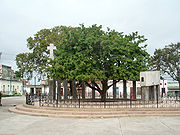
Neglected and Underutilized Crops
Encyclopedia
Neglected and underutilized crops are domesticated plant species that have been used for centuries or even millennia for their food, fibre, fodder, oil or medicinal properties, but have been reduced in importance over time owing to particular supply and use constraints. These can inter alia include poor shelf life, un-recognized nutritional value, poor consumer awareness and reputational problems ("poor people's food"). As the demand for plant and crop attributes changes (re-appraisal or discovery of nutritional traits, culinary value, adaptation to climate change, etc.), neglected crops can overcome the constraints to the wider production and use. As a matter of fact, many formerly neglected crops are now globally significant crops (oilpalm, soybean, kiwi fruit). Although the options for scaling-up neglected crops for large-scale agriculture appear to be increasingly exhausted, many species have the potential to contribute to food security, nutrition, dietary and culinary diversification, health and income generation. They also provide environmental services. It is impossible to define what would constitute "proper" or "correct" levels of utilization, however, it is evident that many neglected species are under-utilized relative to their nutritional value and productivity.
, wheat
and rice
- account for about 40% of the world's consumption of calories and protein. 95% of the world's food needs are provided for by just 30 species of plants. In stark contrast, at least 12,650 species names have been compiled as edible (Kunkel 1984). Neglected and underutilized plants are those that could be - and, in many cases, historically have been - used for food and other uses on a larger scale. Such crop species have also been described as "minor", "orphan", "promising" and "little-used". They continue to play an important role in the subsistence and economy of poor people throughout the developing world, particularly in the agrobiodiversity-rich tropics. Despite their potential for dietary diversification and the provision of micro-nutrients such as vitamins and minerals, they continue to attract little research and development attention.
Alongside their commercial potential, many of the underutilized crops also provide important environmental services, as they are adapted to marginal soil and climate conditions.
 .
.
It is difficult to precisely define which attributes makes a crop "underutilized", but often they display the following features:
Overview
Just three crops - maizeMaize
Maize known in many English-speaking countries as corn or mielie/mealie, is a grain domesticated by indigenous peoples in Mesoamerica in prehistoric times. The leafy stalk produces ears which contain seeds called kernels. Though technically a grain, maize kernels are used in cooking as a vegetable...
, wheat
Wheat
Wheat is a cereal grain, originally from the Levant region of the Near East, but now cultivated worldwide. In 2007 world production of wheat was 607 million tons, making it the third most-produced cereal after maize and rice...
and rice
Rice
Rice is the seed of the monocot plants Oryza sativa or Oryza glaberrima . As a cereal grain, it is the most important staple food for a large part of the world's human population, especially in East Asia, Southeast Asia, South Asia, the Middle East, and the West Indies...
- account for about 40% of the world's consumption of calories and protein. 95% of the world's food needs are provided for by just 30 species of plants. In stark contrast, at least 12,650 species names have been compiled as edible (Kunkel 1984). Neglected and underutilized plants are those that could be - and, in many cases, historically have been - used for food and other uses on a larger scale. Such crop species have also been described as "minor", "orphan", "promising" and "little-used". They continue to play an important role in the subsistence and economy of poor people throughout the developing world, particularly in the agrobiodiversity-rich tropics. Despite their potential for dietary diversification and the provision of micro-nutrients such as vitamins and minerals, they continue to attract little research and development attention.
Alongside their commercial potential, many of the underutilized crops also provide important environmental services, as they are adapted to marginal soil and climate conditions.

It is difficult to precisely define which attributes makes a crop "underutilized", but often they display the following features:
- Linkage with the cultural heritage of their places of origin
- Local and traditional crops whose distribution, biology, cultivation and uses are poorly documented
- Adaptation to specific agro-ecological niches and marginal land
- Weak or no formal seed supply systems
- Traditional uses in localized areas
- Produced in traditional production systems with little or no external inputs
- Receive little attention from research, extension services, policy and decision makers, donors, technology providers and consumers
- May be highly nutritious and/or have medicinal properties or other multiple uses.
See also
- Food securityFood securityFood security refers to the availability of food and one's access to it. A household is considered food-secure when its occupants do not live in hunger or fear of starvation. According to the World Resources Institute, global per capita food production has been increasing substantially for the past...
- Heirloom plantHeirloom plantAn heirloom plant, heirloom variety, or heirloom vegetable is a cultivar that was commonly grown during earlier periods in human history, but which is not used in modern large-scale agriculture...
- List of useful plants
- Slow FoodSlow FoodSlow Food is an international movement founded by Carlo Petrini in 1986. Promoted as an alternative to fast food, it strives to preserve traditional and regional cuisine and encourages farming of plants, seeds and livestock characteristic of the local ecosystem. It was the first established part of...
- Subsistence farming
External links
- Crops for the Future
- The Global Facilitation Unit for Underutilized Species
- Consultation on the Role of Biodiversity in Achieving the UN Millennium Development Goal
- NUS Database Asia
- US Plant Database Search Page
- Spices - by Gernot Katzer
- Photos of Asian Plants - Hiroshima University
- NewCROP the New Crop Resource Online Program

